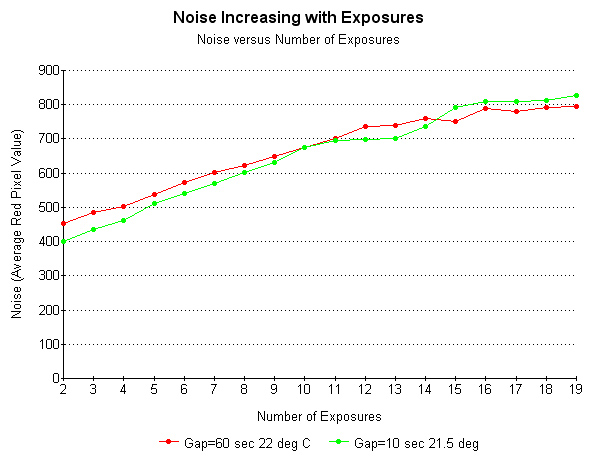Back to Astrophotography
CAMERA NOISE Experiments
I did a series of experiments that examined thermal noise in a Canon 350D
camera. This is an executive summary for a series of five experiments.
Executive Summary
These experiments showed me that it makes little difference if you leave
10 or 60 seconds between subs-exposures (subs). See the graph below. The noise climbs
rapidly, as soon as the camera is turned on, and it continues to climb as more time goes
by. It makes no difference how long you wait between your subs. When you
turn on the camera and take a series of subs the camera is "warming up" and is
getting progressively noisier. After 20 exposures it's twice as noisy as when you
first turned the camera on. Details of a simple experiment (and also the
experimental data) can be found further down the page underneath this graph.
The experiments also demonstrated that temperature has a very big effect
on camera noise. In experiment 5 it is demonstrated
how cooling the camera will dramatically reduce camera noise.

CAMERA NOISE EXPERIMENT (Part 1 - Details) The more you use
it the noiser the camera gets...
This experiment demonstrates that turning a Canon 350D camera on and
taking a series of dark frames results in a series of pictures in which the noise
steadily increases with each new exposure.
1. A Canon 350D (unmodified) camera was turned off and put on a
shelf and was left to adjust to room temperature for over an hour. A digital thermometer
(measuring air temperature) was placed a meter from the camera and was also left to adjust
to room temperature over the same period.
2. The camera was turned on, and immediately upon being Ready the first dark frame
exposure of four minutes duration was taken.
3. Five more dark frame exposures were taken with just a 5 second
interval between each exposure.
4. Three four-minute exposures were then taken with an interval of two minutes
between them.
5. After this the camera was (within 10 seconds) turned off for 10
minutes.
6. After being left turned off for 10 minutes the camera was turned
on again.
7. The last four-minute dark frame exposure was taken less than 10
seconds after turning the camera back on.
8. The RAW files for all exposures were examined in MAXDSLR using Area Mode in
the Information window to get statistics on the image pixel values. The values
for Red pixels are quoted in a table below.
Conclusions for Part 1
a) It is very clear that as soon as you start taking shots the camera is "warming
up" and begins getting noisier. 10% noisier after the first 4 minute exposure.
b) It appears that turning off the camera begins to "cool it
down" and it begins getting slowly less noisey.
c) When the air temperature was 24.7 degrees Centigrade it appears that a two-minute
interval between subs halted the rise in temperature. Sub number 7 clearly shows a
reduction in noise value even though values were climbing through subs 1 to 6.
EQUIPMENT
Canon EOS 350D (unmodified) In-camera Noise Reduction Off; ISO 1600.
Digital thermometer to measure air temperature
DATA for Part 1
| Sub |
Exposure
Minutes |
Interval
Seconds |
Temp
Deg C |
Noise**
(Pixel Value) |
Std Dev
(Pixels) |
Total Noise
(Pixel values) |
Reference
Time |
| 1 |
4:00 |
- |
24.5 |
931 |
1605 |
0.789469e10 |
00:00 |
| 2 |
4:00 |
5 |
24.5 |
1048 |
1904 |
0.842596e10 |
04:05 |
| 3 |
4:00 |
5 |
24.7 |
1254 |
2229 |
1.008310e10 |
08:10 |
| 4 |
4:00 |
5 |
24.7 |
1386 |
2509 |
1.114290e10 |
12:15 |
| 5 |
4:00 |
5 |
24.7 |
1578 |
2775 |
1.258583e10 |
16:20 |
| 6 |
4:00 |
5 |
24.7 |
1709 |
3003 |
1.374348e10 |
20:25 |
| 7 |
4:00 |
120 |
24.7 |
1688 |
3074 |
1.357372e10 |
26:25 |
| 8 |
4:00 |
120 |
24.7 |
1687 |
3135 |
1.356346e10 |
32:25 |
| 9 |
4:04oops |
120 |
24.7 |
1758 |
3264 |
1.413554e10 |
38:25 |
| 10 |
4:00 |
600 |
24.6 |
1489 |
2622 |
1.197685e10 |
53:00 |
** These exposures are dark frames. The average value of Red pixels
is used here in the table as a measure of noise.
This investigation is continued with further experiments in parts
2, 3,4 and 5:
Go to Part 2 Go to
Part 3 Go to Part4 (Fan
Cooling) Go to part 5 (Peltier Cooling)
Back to Astrophotography
|

